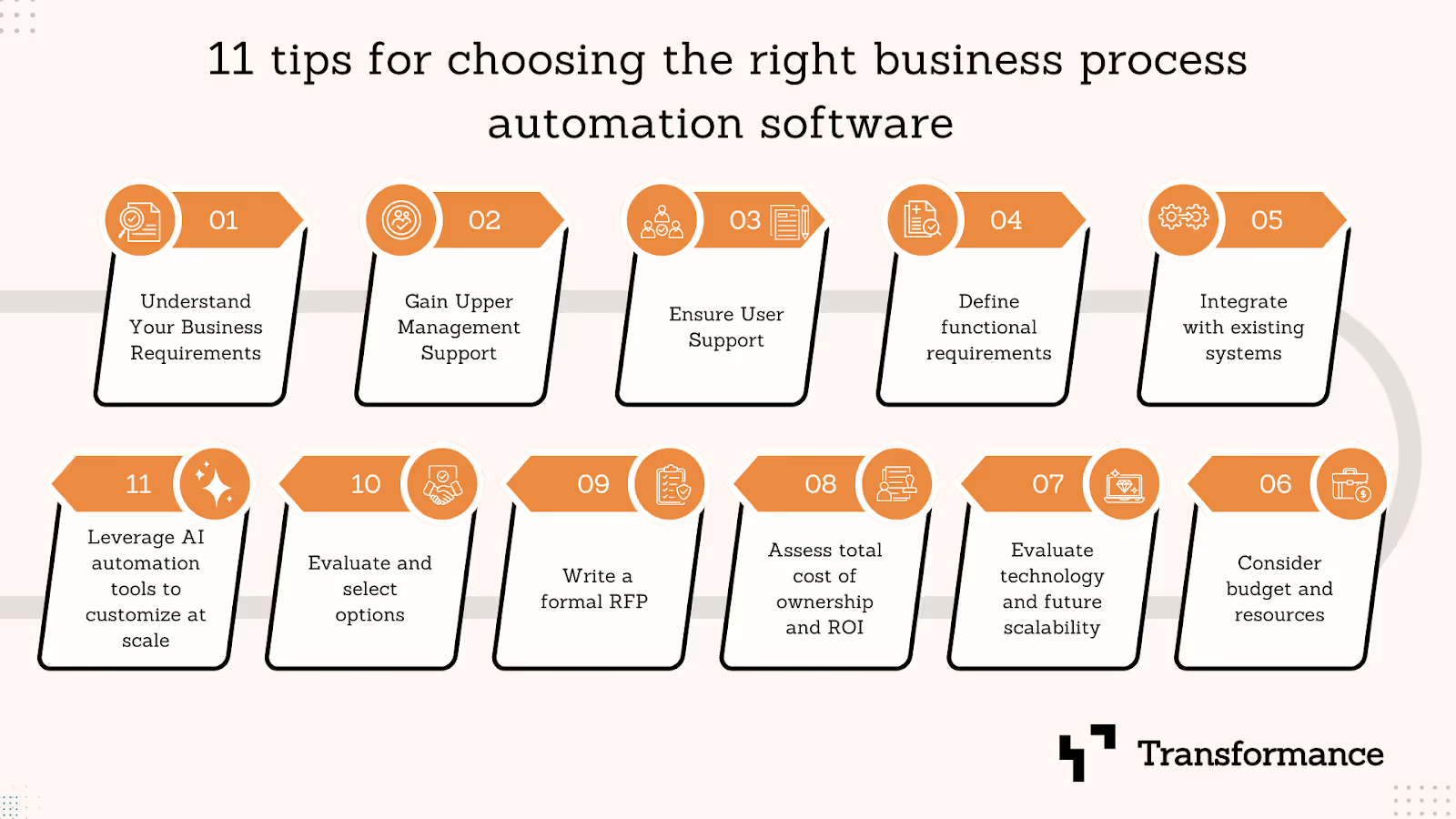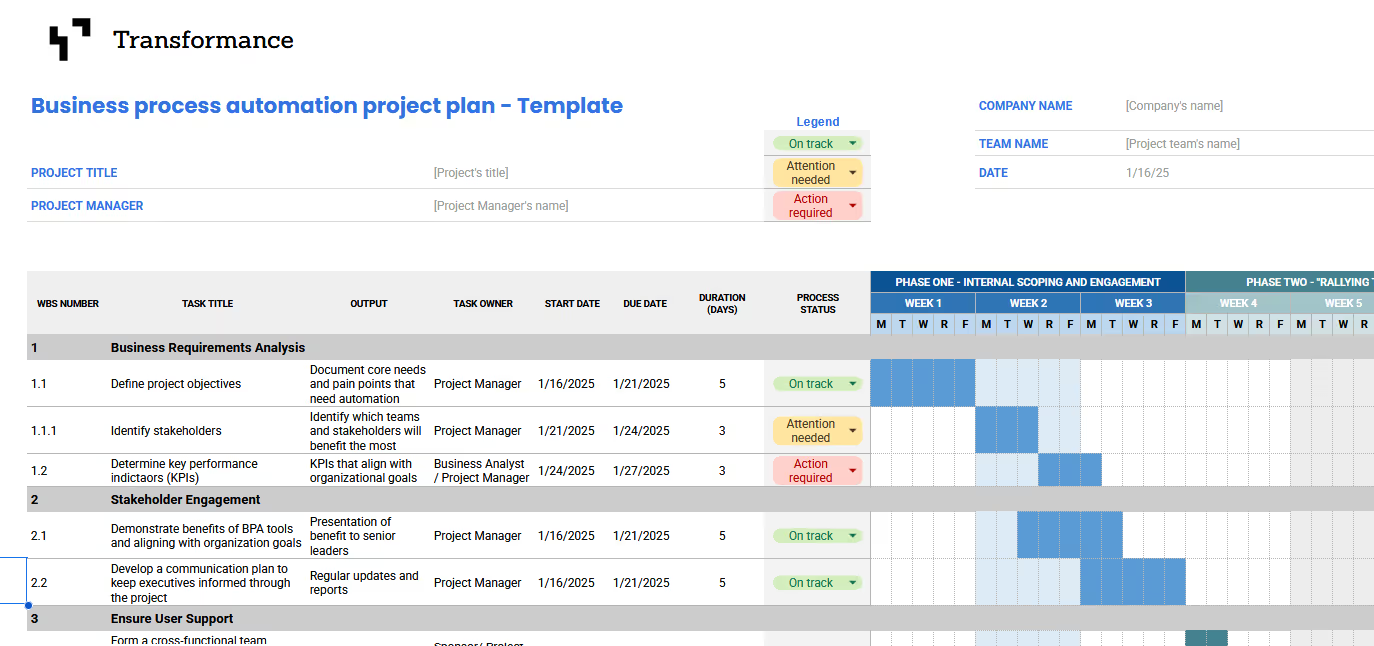What is Business Process Automation?
Business process automation (BPA) involves using technology to automate complex and repetitive tasks, streamline workflows, and improve your teams’ efficiency. BPA platforms are the most deployed form of automation, according to McKinsey, as they can be most horizontally applied.
Survey findings from McKinsey show that prioritizing automation has become increasingly important for achieving efficiency gains.
For a full summary of business process automation read our article “What is business process automation?”
Top 11 Tips for Choosing the Best Business Process Automation Tools

1. Understand Your Business Requirements
Before you start your BPA exploration, it’s crucial to nail down your business requirements. Which teams will benefit the most? Which internal stakeholders have the greatest pain points? As a result: which processes do you want to automate? Identifying your company’s core needs will help you narrow down your options and select a tool that fits your requirements.
Pro tip: Read our article “6 steps to using business process automation” which includes a step-by-step guide from setup to execution.
2. Gain Upper Management Support
Upper management support is crucial for the successful implementation of any new system. Senior leaders need to understand the benefits of the BPA tool and be committed to supporting its adoption. This support often translates into the necessary resources, both in terms of budget and personnel, to ensure a smooth transition.
Pro tip: Engage senior leaders early in the process. Clearly communicate the advantages of BPA tools and how they align with organizational goals. Their buy-in will facilitate a more effective implementation. A great BPA provider like Transformance will be more than happy to help you build this internal case with you.
3. Ensure User Support
User support is another critical factor. Your team will be the primary users and beneficiaries of the BPA tool, so it’s important that they are on board with the selection process. Gather feedback from potential users and involve them in the evaluation process. Their insights can provide valuable information about usability and functionality that might not be evident from a technical perspective alone.
Pro tip: Create a cross-functional team that includes end-users. Regularly solicit their input during the evaluation phase to ensure the chosen BPA tool meets their needs and enhances productivity.
4. Define Functional Requirements
Clearly define the functional requirements for your BPA solution. These include the specific features and capabilities that the software must have to meet your needs. For example, if you require extensive workflow automation solutions or specific data automation software features, ensure these are included in your list of requirements.
Pro tip: Prioritize features based on business priorities. Consider essential functionalities such as process modeling, integration capabilities, and scalability. Align these requirements with your organization’s strategic goals.
5. Integrate with Existing Systems
One of the most important aspects of selecting a BPA tool is its ability to integrate with your existing systems. Whether it’s your ERP, your CRM, or any other critical part of your IT infrastructure, your new BPA platform should seamlessly fit in. Integration capabilities will impact the efficiency of your workflows and the overall success of the automation.
Pro tip: Evaluate integration options early. Good solutions will have the necessary integrations out of the box. Cutting-edge platforms like Transformance have a set of standard integrations and let you generate any custom integration from scratch using AI.
6. Consider Budget and Resources
Budget constraints are a reality for all businesses and teams. Make sure you are aware of the currently available budget for the BPA implementation. Ask your potential implementation partners early on how many implementation resources you will require in addition to the solution investment. This will help you avoid unpleasant surprises and - even worse - unhappy project sponsors.
Pro tip: Identify business cases across teams and consider involving a CoE or business service responsible. Growing your team of internal stakeholders can help you find new budgets. A strong business case (see point 8) can further help to expand your budget.
7. Evaluate Technology and Future Scalability
Your BPA tool should not only meet your current needs but also be scalable for future growth. Evaluate the technology behind the software to ensure it can handle increasing workloads and adapt to evolving business requirements. Scalability is crucial for long-term success and can prevent the need for frequent software replacements.
Pro tip: AI is the future but not many companies have tools which make it useful. Ask your potential partners about their use of AI and challenge them on functionality and benefit.
8. Assess Total Cost of Ownership and ROI
When drawing out your business case, consider the total cost of ownership. This includes implementation, training, and maintenance costs. Additionally, evaluate the potential return on investment (ROI) the software can deliver. An effective BPA tool should offer significant time and cost savings, improving overall efficiency and productivity.
Pro tip: Look for solutions that clearly communicate the cost of implementation and operation while offering good value for money. Best-in-class providers like Transformance will help you when creating the business case. Lastly, assess whether the cost fits within your financial resources.
9. Write a Formal Request for Proposal (RFP)
A well-designed Request for Proposal (RFP) is crucial to acquire detailed information from potential vendors. The RFP should outline your business needs, technical requirements, and budget constraints. This will help vendors provide precise proposals and ensure that you receive comprehensive and relevant information to make an informed decision.
Pro tip: The best vendors like Transformance will share best practices for RFP criteria and help you navigate the process. Ask your potential partners for advice on evaluation criteria to assure you know the realm of the possible when drafting the RFP.
10. Evaluate and Select Options
Once you have gathered proposals and demos, it’s time to evaluate and select the best option. Compare the features, costs, and benefits of each BPA solution. Consider conducting demos and trials to test the software in a real-world scenario. This hands-on approach will provide a clearer picture of how well each fits with your business processes.
Pro tip: Have your dedicated project manager collect and define the evaluation criteria and make sure all relevant stakeholders are involved and share ownership over the decision. This will increase buy-in and make implementation and change management much easier.
11. Leverage AI automation tools to customize at scale
When evaluating BPA tools, explore their capacity for customization. Consider how well each option aligns with your business processes and whether it can be tailored to meet your specific needs. By leveraging AI-driven customization, you can achieve scalability without compromising implementation timelines or costs. Transformance is the AI-native BPA platform that enables you to build your own workflows, transformations, and integrations at scale without any IT support. Get in touch to learn how in a free consultation.
Pro tip: Challenge providers like Transformance on the usefulness of their AI features. Are they actually adding value or merely trying to ride the AI wave?
Summary: Choosing the right business process automation software
Selecting the right BPA is essential for streamlining operations, improving productivity, and reducing costs. This guide outlines 11 key tips to help you make the best choice. Start by understanding your business needs and secure support both from management and users. Then, define functional requirements, considering how the software integrates with your existing systems and fits with your budget. Finally, compile these details into a formal Request for Proposal (RFP) to guide your selection process effectively.
Bonus: Business Process Automation Tool Checklist
To streamline your selection process, use a checklist to ensure that you’ve considered all critical factors.
Download your free Excel checklist [here] to evaluate different BPA tools based on functionality, integration, scalability, and cost.

Business Process Automation Selection FAQs
What are the criteria for selecting a business process automation tool?
Key criteria include functionality, integration capabilities, scalability, user support, budget, and total cost of ownership. Ensure the tool meets your specific needs and can grow with your business.
What type of businesses is business process automation most appropriate for?
Business process automation tools are suitable for organizations of all sizes, but they are especially beneficial for those with complex processes, high process transaction volumes, or a need for enhanced efficiency. Industries such as finance, manufacturing, and healthcare often see significant benefits from BPA solutions.
How do you evaluate business process automation solutions?
Evaluate BPA solutions by assessing their functionality, ease of integration with existing systems, scalability, user support, and cost. Consider conducting trials or pilots to test the software’s effectiveness in your environment.
Does a small business need a business process automation tool?
Yes, small businesses can benefit from BPA tools, particularly if they are experiencing growth or have repetitive tasks that could be automated. BPA tools can help small businesses improve efficiency and reduce manual errors. However, the requirements and tools to select will differ starkly depending on the integrations needed and the complexity of the processes. Smaller companies often prefer simpler integration tools like Zapier or Make while larger companies tend to prefer more enterprise readiness like Transformance, UiPath, or Appian.
Which industries can benefit from business process automation solutions?
Because virtually all companies have repetitive internal processes, BPA is not limited to any one industry. Most often, companies start with the most repeatable processes in their core businesses. These are mostly central support functions like Finance, Procurement, HR and IT but can also include market-facing functions like sales or marketing where repetitive, yet creative tasks can often benefit from a mix of automation and generative AI.
What should I look for in a new business automation software?
Look for software that offers comprehensive functionality, seamless integration with existing systems, scalability for future growth, user support, and a clear ROI. Ensure the software aligns with your specific business needs. For a full list read out article “11 Tips for choosing the right business process automation software”.
What is an ideal business process automation tool?
An ideal BPA platform should provide robust workflow automation, seamless integration capabilities, scalability, user-friendly interfaces, and strong customer support. Solutions like Transformance can also help you deploy AI Copilots for creating processes, making scalability particularly effective for large enterprises.






